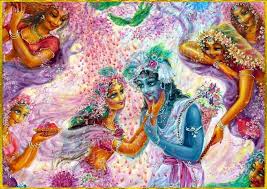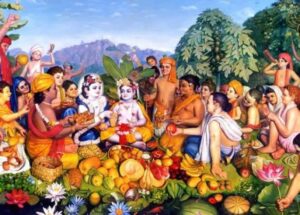One day, Krishna and His cowherd friends were wandering in the enchanting forests of Vrindavan. As they were exploring, Krishna felt hungry. Noticing His hunger, a nearby mango tree, out of its devotion and love for Krishna, lowered its highest branch to bring a ripe mango within Krishna’s reach. Krishna picked the mango and savored it, delighting in its sweetness.
Madhumangala, one of Krishna’s dear friends, observed this and exclaimed, “Oh, this is not fair! I would like to get such a mango too!”
Krishna, with a playful smile, said, “Madhumangala, just stand before the tree and meditate on how much you want the mango. The tree will give it to you.”
Trusting Krishna’s words, Madhumangala stood before the tree and meditated earnestly, envisioning the mango in his mind. However, nothing happened. The tree remained still, and no mango appeared.
Frustrated, Madhumangala called out, “Krishna, nothing is happening! This is not working!”
Krishna, amused, responded, “No, no, Madhumangala. You are not doing it properly. Let me show you the proper way to get your mangos!”
With a twinkle in his eye, Balarama stepped forward. “Madhumangala, I’ll help you out,” he said. Balarama grasped the trunk of the tree firmly and gave it a good shake. Immediately, hundreds of mangoes rained down from the tree, many landing right on Madhumangala’s head.
“Ouch! That hurts,” Madhumangala exclaimed, rubbing his head. But soon he laughed and said, “No problem, I got my mangoes!”
Moral of the Story
This charming story from the pastimes of Krishna and His friends in Vrindavan highlights several important values:
- Devotion and Service: The mango tree’s act of lowering its branch to offer a mango to Krishna demonstrates pure devotion. When our actions are motivated by sincere love and service to the Lord, they are naturally fruitful and fulfilling.
- Faith and Patience: Madhumangala’s initial attempt to get a mango through meditation represents the need for faith and patience in our spiritual practices. Sometimes, results may not be immediate, but persistence and trust in the divine process are crucial.
- Playfulness and Joy in Devotion: Krishna and His friends’ playful interaction reminds us that spiritual life should be filled with joy, laughter, and companionship. Serving the Lord and being in the company of devotees is inherently blissful.
- Helping Each Other: Balarama’s intervention shows the importance of helping each other in our spiritual journey. Sometimes, we need a little assistance from friends or spiritual guides to achieve our goals.
- Gratitude: Despite the initial discomfort, Madhumangala’s happiness at receiving the mangoes signifies gratitude. Being thankful for what we receive, even if it comes with some challenges, is a key aspect of a fulfilling spiritual life.
Conclusion
The story of Krishna, Balarama, and Madhumangala with the mango tree is a delightful reminder of the sweetness and simplicity of devotional life in Vrindavan. It encourages us to approach our spiritual practice with sincerity, joy, and a helping spirit. By meditating on the loving pastimes of the Lord and His associates, we can deepen our own devotion and experience the transcendental bliss that comes from serving Krishna.
Hare Krishna, Hare Krishna, Krishna Krishna, Hare Hare Hare Rama, Hare Rama, Rama Rama, Hare Hare.
PS: I humbly request all the devotees to please forward and share this moral/instructive story so that everyone can be benefited by hearing about Krishna and His dear devotees.



